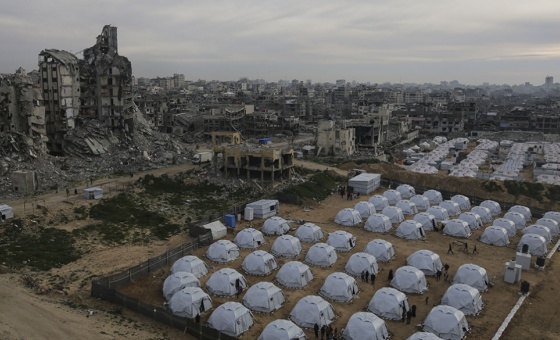This is the last article you can read this month
You can read more article this month
You can read more articles this month
Sorry your limit is up for this month
Reset on:
Please help support the Morning Star by subscribing here
JUNE 6 2024 is the 80th anniversary of the launch of the Normandy landings, or D-day. Back on June 6 1944 it marked the start of the battle of Normandy, which ended on August 30 1944.
This Allied military operation to open a second front in the west against the Nazis, which helped relieve pressure on the Soviet Union fighting in the east, is also known as Operation Overlord. It eventually led to the successful liberation of German-occupied western Europe during World War II.
While we pay tribute to the courage and self-sacrifice of those who died in that battle, we should also remember — as Winston Churchill, Britain’s wartime prime minister, acknowledged in a speech on August 2, 1944 — that it was the Red Army of the Soviet Union who did the “main work in tearing the guts out of the German army,” making victory in the west possible.
Here are 10 key facts about D-day and the battle of Normandy.
1. In the early hours of June 2 1944, 20,000 British and US airborne soldiers descended by parachute and glider in the areas of Ranville and St Mere and Eglise in Normandy.
Employing 1,200 transport aircraft and 188 gliders, this was the largest airborne landing executed to that date. It was, however, merely the opening phase of a larger operation, the next stage of which commenced six hours or so later.
2. After the airborne assault came the amphibious assault. Approximately 7,000 naval vessels, including battleships, destroyers, minesweepers, escorts and assault craft took part.
Approximately 160,000 troops crossed the English Channel on June 6. The sea landings started at 6.30am local time, just after dawn, targeting five code-named beaches, one after the other: Omaha, Utah, Gold, Sword, Juno.
3. Middlesbrough-born Stanley Hollis was the only man to win a Victoria Cross (VC) on D-day. Stan Hollis was company sergeant major, D Company, 6th Battalion Green Howards.
This battalion was one of two that were in the first wave of landings, King Sector, Gold Beach, at 7.32am on the morning of D-day.
4. Approximately, 175 Native American soldiers landed on Omaha Beach on June 6 1944 as part of the Normandy invasion. Many other Indigenous North American servicemen and women also contributed to D-day and experienced the preparations surrounding the operation while stationed in Britain.
5. On June 6 1944 many of the immediate strategic objectives of the landings were not achieved, including the failure to capture any of the key towns. But D-day was still a huge success, as approximately 160,000 Allied troops and 6,000 vehicles had crossed the Channel and established a foothold in France.
6. The Allied invasion of Europe, originally planned for June 5, had to be postponed due to bad weather. A further postponement would have meant a delay of at least two weeks, as the planners had requirements for the phase of the moon, the tides, and time of day, that meant only a few days each month were deemed suitable.
7. The US army was the western invasion force, landing on Utah and Omaha beaches. The eastern invasion force was made up of British troops, landing at Gold and Sword beaches, and the Canadians, landing at Juno.
The highest casualties occurred on Omaha beach, where 2,000 US troops were killed, wounded or went missing; at Sword Beach and Gold Beach, where 2,000 British troops were killed, wounded or went missing; and at Juno beach, where 340 Canadian soldiers were killed and another 574 wounded. The German casualties on D-day have been estimated at between 4,000-9,000 men.
8. Before D-day, the Allies misled Germany about the intended invasion target by carrying out a large-scale deception campaign.
The Allies used fraudulent radio transmissions, fake equipment and a ghost army stationed in England across from Pas-de-Calais with George Patton as its commander.
9. The Soviet Union’s Red Army didn’t take part in the D-day landings or the battle of Normandy directly. However, it’s generally accepted that Nazi Germany lost World War II on the eastern front.
The German army in the west had been weakened by the removal of troops to fight on the eastern front against the Soviet Union, notably in the battles of Stalingrad in 1942 and Kursk in 1943.
Moreover, for most of the war, 75 to 80 per cent of the Wehrmacht had to be deployed in the east, a preponderance dictated by the sheer size of the front, and 80 per cent of German war dead perished there: about four million of the five million German soldiers killed in World War II.
10. An estimated 20,000 French civilians died during the two month battle of Normandy. Most were killed by Allied bombing of French cities and villages.
The cities of Le Havre (1,770 civilians killed), Caen (1,741), Rouen (883), Saint-Lo (400) and Falaise (350) especially suffered. Still, proportionally, it was the small town of Evrecy in the Calvados department, with 62 dead for a population of 460, that suffered the most.










